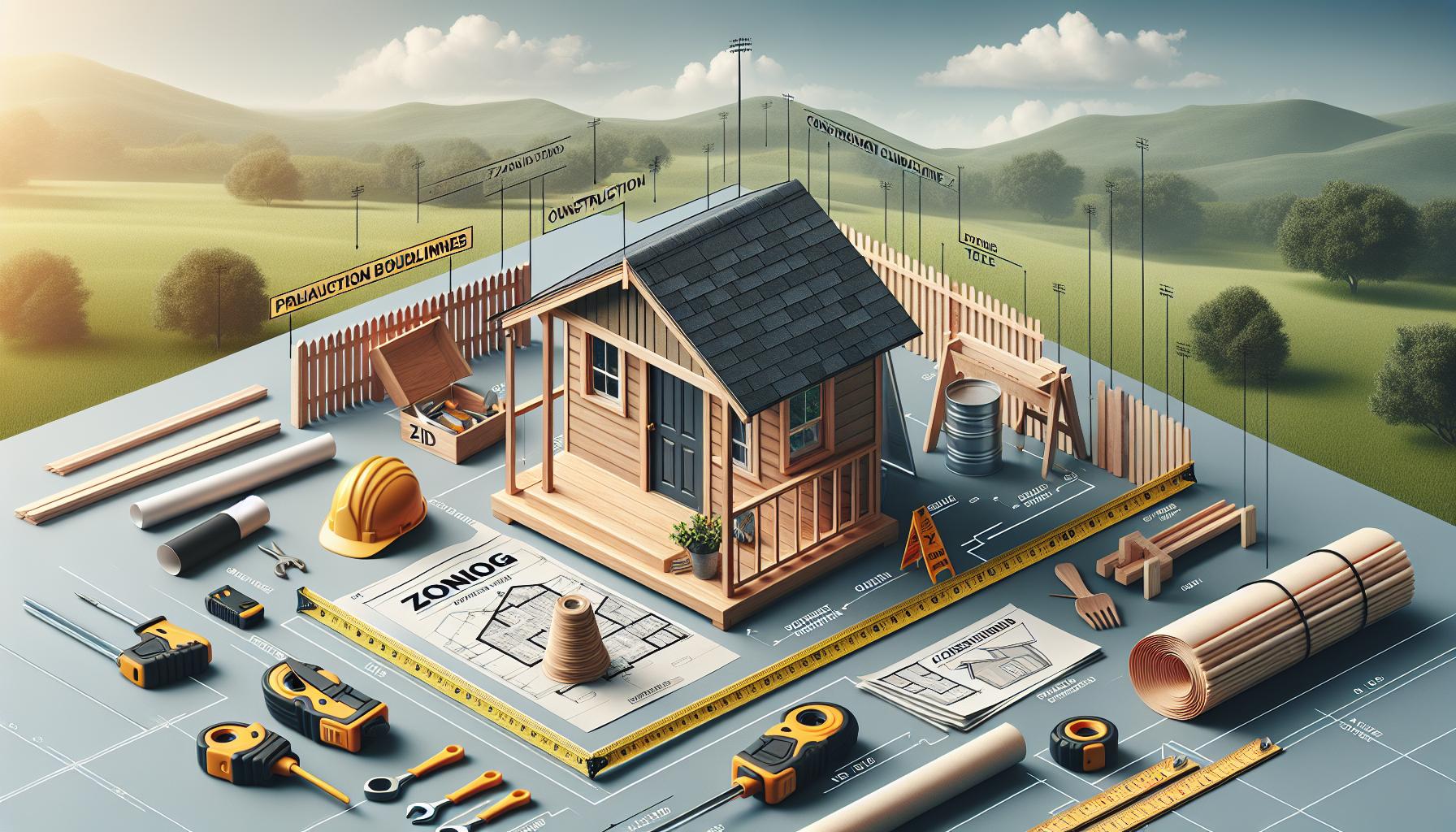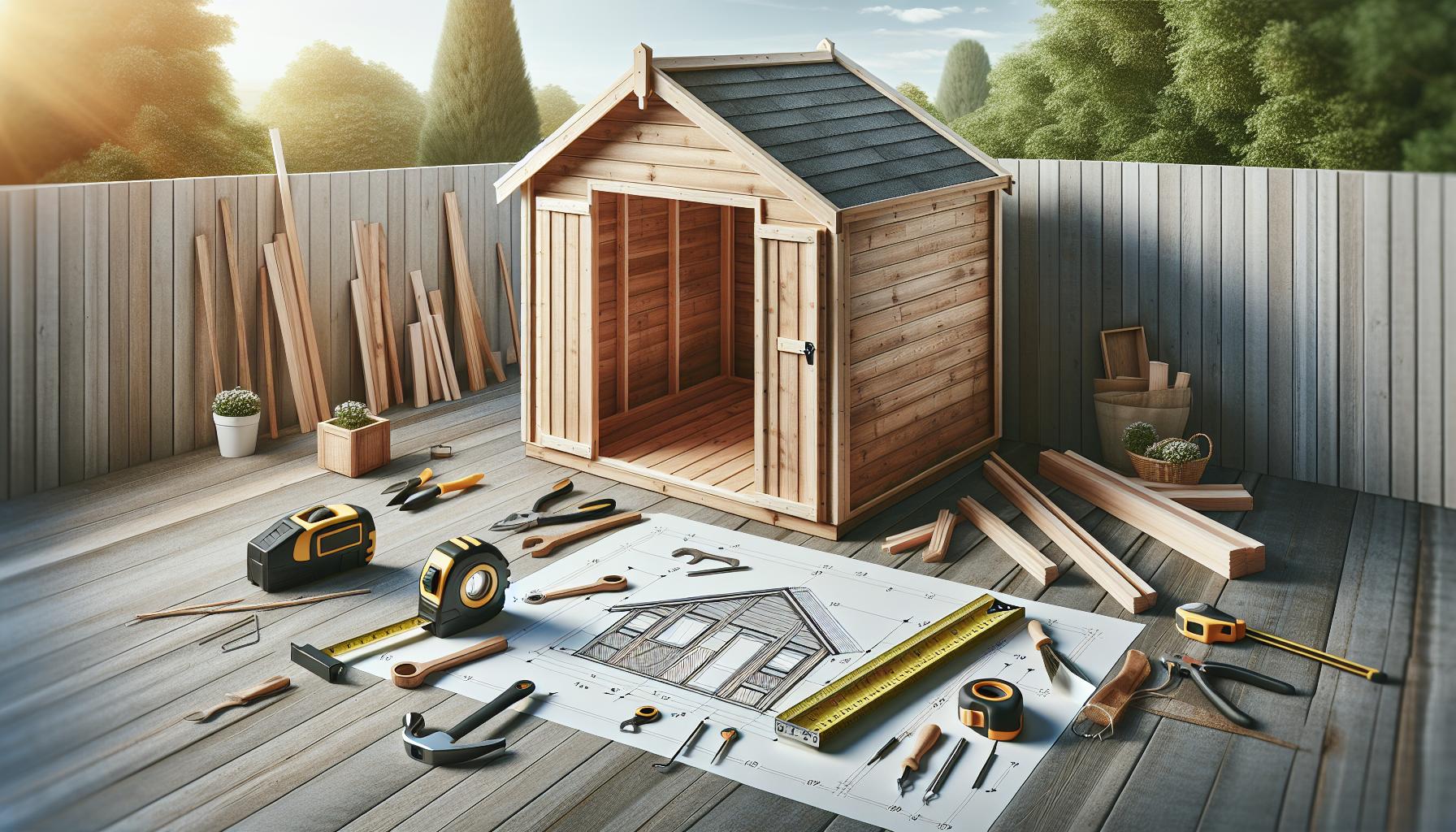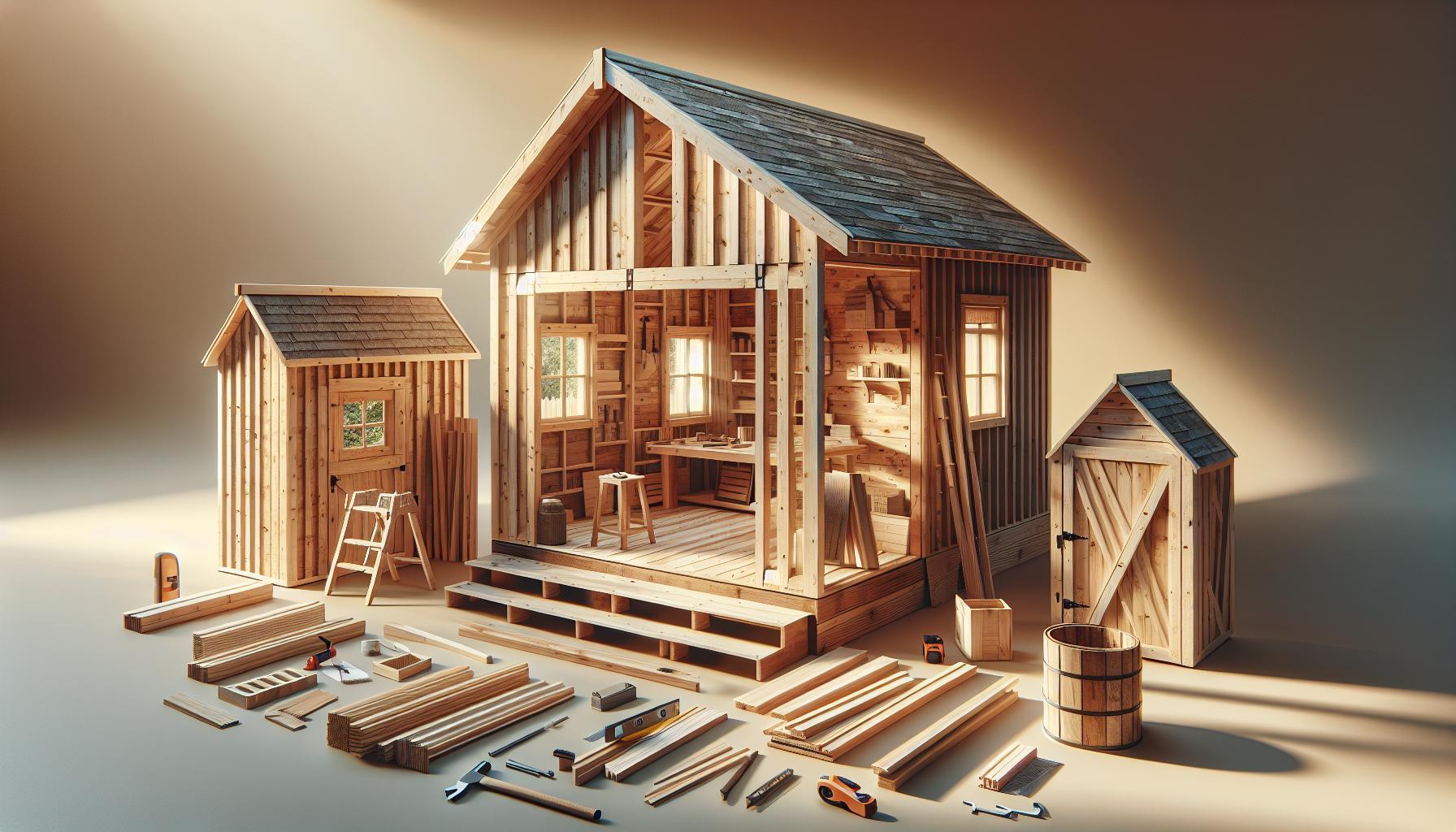When considering a backyard shed, understanding local regulations on height is crucial to avoid complications. Many homeowners wonder how tall they can build a shed without needing planning permission, as exceeding height limits can lead to fines or required modifications. This guide explores key height restrictions and factors to ensure your project stays compliant and hassle-free.
Understanding Planning Permission: What You Need to Know
Building a garden shed can be an exciting project, but it’s crucial to understand the implications of planning permission before you begin. Many homeowners are unaware of the regulations that govern the construction of outbuildings, leading to potential legal issues further down the line. Each country and locality may have diffrent regulations, so it’s essential to familiarize yourself with the specific requirements in your area, especially regarding height limits and proximity to property boundaries.
When considering how tall you can construct a shed without requiring planning permission, several factors come into play. Most jurisdictions allow for sheds under certain height limits—typically around 2.5 meters when located within two meters of a boundary. If your shed is further away, the height limit might increase to around 4 meters, depending on local regulations. Understanding these dimensions not only helps you comply with the law but also ensures that your shed won’t obstruct your neighbor’s light or views, thereby fostering good relationships with those nearby.
Additionally, factors such as the overall footprint of your shed can influence whether you need planning permission. In many cases, sheds should not cover more than 10 square meters unless they adhere to specific criteria set for larger constructions.If you live in a listed building or a conservation area, obtaining planning permission beforehand is often mandatory. Always check the local council’s guidelines or consult a professional to ensure you are acting within the legal boundaries.
for a clear breakdown of the general rules regarding shed construction, consider the following table summarizing the typical height permissions based on distance from boundaries:
| Distance from Boundary | Max Height Without Permission |
|---|---|
| Within 2 Meters | 2.5 Meters |
| More than 2 meters | 4 Meters |
Before you start your project, take the time to research and comprehend local planning laws.By doing so, you’ll not only protect your investment but also enhance your outdoor space without running afoul of regulations. Always reach out to your local planning authority if you’re uncertain about the specific requirements related to building a shed in your area.
Common Regulations for Shed Heights in Residential Areas
Understanding the common regulations regarding shed heights in residential areas is essential for anyone considering building a structure in their backyard. Local authorities often set specific guidelines that help maintain neighborhood aesthetics, provide safety, and ensure proper land use. These regulations can vary significantly depending on the city or county, making it crucial for homeowners to familiarize themselves with the rules that apply to their area.
In general, most jurisdictions allow homeowners to construct sheds without needing a building permit, provided the structure adheres to certain height restrictions. Commonly, sheds must remain below a height of 2.5 meters (approximately 8.2 feet) when within two meters of a property boundary. For sheds positioned further from property lines,the maximum eaves height usually remains at 2.5 meters, but the total height of the shed can reach up to 4 meters with a dual-pitched roof or 3 meters with a flat or othre types of roof designs.
Key Height Regulations to Consider
When planning your shed,consider these typical height regulations:
| Distance from Boundary | Maximum Eaves Height | Maximum Overall height |
|---|---|---|
| Within 2 Meters | 2.5 Meters | 2.5 Meters |
| More than 2 Meters | 2.5 Meters | 4 Meters (Dual Pitched) / 3 Meters (Other Roofs) |
Additionally, various counties may impose different limitations.For instance, in areas governed by stricter building codes, such as some counties in California, it’s vital to check local regulations, especially if your shed exceeds 120 square feet, as different rules apply based on size and height. Always consult your local council or planning authority for the most accurate and relevant facts.
By adhering to these guidelines, you can avoid potential disputes with neighbors and compliance issues with local authorities. Understanding how high you can build a shed without needing planning permission is a key step in successfully establishing your new outdoor space while ensuring it aligns with community standards.
Variations in Local Codes: Navigating Your Area’s Requirements
When planning to construct a shed, it’s essential to understand that local codes and regulations can vary significantly, which can affect how high you can build a shed without needing planning permission. Many homeowners are surprised to find that what is permitted in one area may not be allowable in another, making it essential to research your local ordinances thoroughly. Failure to comply with these regulations can lead to fines, forced removal of the shed, or other legal issues.
In many locations, the height limits for sheds can depend on factors such as proximity to property lines, zoning designations, and whether the area is designated for residential or commercial use. For instance, some municipalities impose restrictions that specify sheds cannot exceed a certain height—often around 10 to 12 feet—measured from the ground to the highest point of the structure. Additionally, if your property is located within a historic district or an area with specific aesthetic regulations, there may be additional restrictions regarding the appearance and height of outbuildings.
key Considerations for Local Codes
When navigating local building codes,consider the following steps to ensure compliance:
- Consult Local Building Departments: Before starting your project,contact your local planning or building department to inquire about specific height restrictions and permit requirements.
- Review Zoning laws: Check both residential and commercial zoning laws that might apply to your property, as these can dictate what structures are allowable.
- Analyze Nearby Structures: Take note of the heights of neighboring sheds and structures; this can provide insight into local norms and practices.
- Inspect Covenants and Restrictions: If your property is part of a homeowners’ association (HOA) or similar group, review any covenants that might impose additional restrictions.
Understanding the regulations that dictate how high you can build a shed without planning permission is critical. Such as,in some states like New York,specific guidelines might stipulate that structures within a certain distance to the property line must adhere to more stringent height restrictions.
To summarize, navigating your area’s specific requirements is crucial for a smooth and compliant shed-building experience. By performing diligent research and considering all local regulations, you can avoid potential pitfalls and ensure that your shed project aligns with both your needs and legal standards.
Creative Solutions for Maximum Shed Height without Overstepping
Determining the appropriate height for your shed while avoiding the need for planning permission presents a unique challenge. Many homeowners are eager to maximize their storage options without encountering regulatory hurdles, especially in areas where space is at a premium. Understanding local regulations and exploring creative constructions can definitely help ensure your shed meets your needs without breaking any rules.
When considering how high you can construct your shed, start by familiarizing yourself with the typical limits set by local councils. In many regions, single-story structures fall beneath a maximum height threshold—frequently enough around 2.5 meters (approximately 8.2 feet) at the eaves. To maximize storage while remaining within these limits, you can utilize the following strategies:
- Use Lean-to Designs: These can frequently enough be attached to existing structures, optimizing vertical space by sloping the roof towards the wall. Lean-tos blend well and maintain a lower profile.
- Incorporate Shelving: Use the internal height effectively by installing shelves and mezzanines. This allows for the vertical stacking of tools and equipment without increasing the overall height of the building.
- Built-in Loft Options: If permissible, a loft can provide additional storage without raising the overall height significantly. Ensure that the overhead clearance still allows easy access.
- Choose a Roof Style Wisely: Opting for a gable or slanted roof can give the shed a taller appearance while staying within planning height restrictions.
Aside from design strategies, if your site allows for it, consider adjustments to the ground level. Raising your shed slightly off the ground not only protects against moisture but can also provide better drainage on sloped terrain. However, it is crucial to balance this with local height regulations to ensure you do not inadvertently exceed the permissible shed height.
Lastly, always check for specific local building codes and regulations, as these can vary significantly from one area to another. Engaging with your local council early in your planning phase coudl save you time and ensure you make informed decisions as you explore how to creatively maximize storage while adhering to the guidelines outlined in the ‘How High Can I Build a Shed Without Planning Permission? Height Guide’.
The Importance of Neighbors’ Rights and Boundary Considerations
Understanding and respecting the rights of neighbors is critical when considering any construction project, even one as seemingly uncomplicated as building a shed. In many residential areas, there are specific rules and regulations about the height and placement of structures to avoid infringing on a neighbor’s property rights.For instance, the general query of “How High Can I Build a Shed Without Planning Permission?” can take on new dimensions if it may infringe upon existing easements or property boundaries that neighbors rely upon.
why Neighbor Awareness Matters
being aware of your neighbors’ rights can prevent disputes and foster a sense of community. Constructing a shed with inadequate consideration for neighboring properties can lead to various challenges, including potential legal actions if the structure encroaches on shared boundaries.The laws surrounding property lines can be complex, and misunderstandings often arise regarding what is permissible. It is crucial to verify the location of your property line and ensure that your shed complies with local regulations, which typically dictate not only height limitations but also proximity to neighboring properties.
- Review local zoning laws and building regulations.
- Consult neighbor(s) before finalizing construction plans.
- Consider obtaining a land surveyor to clearly define property boundaries.
Boundary Disputes and Their Resolution
in scenarios where boundaries are unclear, disputes may arise, which can complicate or even halt your project. The most common solution involves open interaction with your neighbors to address concerns they may have about your construction plans. If a disagreement escalates, legal remedies such as quieting a title or negotiating easements might potentially be necessary. It is always advisable to document any agreements made with neighbors to avoid future misunderstandings.
| Action | Considerations |
|---|---|
| Consult Local Zoning Laws | Understand height restrictions and property line regulations. |
| Communicate with Neighbors | Gauge their opinions and address potential issues directly. |
| Hire a surveyor | Establish clear property boundaries before starting construction. |
Being proactive about understanding your neighbors’ rights and the legal constraints governing construction can significantly mitigate conflict. By putting in the effort to consider the implications of your shed height and placement, you create a harmonious living environment while ensuring that your project aligns with community standards and regulations. This thoughtful approach not only serves your interests but enhances relationships with those living nearby.
Practical Tips for Measuring Your Shed’s Height Correctly
Measuring the height of your shed accurately is crucial for ensuring that you comply with local regulations and maximize your space without running into issues later. Many homeowners are unaware that the shed’s total height includes not just the peak of the roof but also the foundation and any accessories that may be added, such as roof racks or vents. Understanding the specific height limits relevant to your area helps prevent any potential planning permission disputes and maintains harmony with your neighborhood.
To begin with,gather the right tools: a tape measure,a level,and,if possible,a second person to help hold the measurement. Start at the base of the shed; measure from the ground to the highest point of the roof. Make sure to take note of whether the ground is level or sloping, as this can affect your overall height measurement. Here are some practical steps to follow when measuring your shed’s height:
- Choose a clear day: Ensure minimal disturbances like wind or rain during your measurement.
- Use a level: If you’re measuring a larger shed, a level can help you find the highest point more easily.
- Account for additional features: Measure any features that may rise above the standard height,such as decorative shingles or antennas.
Understanding local Regulations
Additionally,it’s beneficial to research your local zoning laws regarding shed heights. Many areas have specific guidelines on how tall your shed can be without requiring planning permission. Generally,in residential zones,this is frequently enough between 2.5 and 3 meters. Always double-check with your local authority to verify current regulations like those detailed in guides discussing how high you can build a shed without planning permission.
Consider creating a table to summarize the height restrictions relevant to your area,enabling quick reference when planning your shed:
| Location | Maximum Allowed Height | Planning Permission Required |
|---|---|---|
| Residential Areas | 2.5 – 3.0 meters | Depends on height and proximity to boundaries |
| Commercial Areas | Varies by specific permits | Yes, typically required |
| Agricultural Zones | 4.0 meters | No, under certain conditions |
Taking these measurements and considerations seriously will greatly enhance your readiness for local regulations and ensure a triumphant shed project that adds value to your home without unwanted surprises.
Enhancing Design While Staying Within Legal Limitations
In the world of shed construction, understanding legal limitations can be as crucial as the design itself. By staying compliant with local regulations, homeowners not only avoid fines but also enhance the usability and aesthetic appeal of their outdoor structures. When considering the question of how high can a shed be built without planning permission, it’s essential to navigate the balance between creativity and legislation, ensuring that the design not only meets personal needs but also adheres to legal guidelines.
One effective approach is to utilize design constraints as a tool for creativity. These restrictions can come from local zoning laws, which might dictate maximum height, distance from property lines, or even specific usability parameters. By embracing these limitations, you might discover innovative architectural solutions that you hadn’t considered before. For instance,if the legal height limit is set at 2.5 meters, incorporating a sloped roof can create the illusion of added height without breaching regulations. This not only keeps you within limits but can also add character to the structure.
Practical Design Tips Within Regulatory Frameworks
To enhance your shed design while remaining within legal confines, consider the following strategies:
- Optimize Dimensions: Use measurements below the maximum allowed height and ensure compliance with any width limitations as well.
- Choose Appropriate Materials: Some materials may meet aesthetic goals while also being lighter and easier to manage, simplifying the construction process within height regulations.
- Design for Functionality: Rather of focusing solely on height, think about how to maximize your shed’s vertical space internally by adding shelving or organizing tools efficiently.
- Seek Expert Advice: Consulting with local building officials or architects can provide insights into other creative options that comply with regulations.
A thorough understanding of the legal height restrictions can lead to unique design solutions that add value to your property. For exmaple, if the allowable height is limited, consider a multi-level shed that cleverly uses elevation for storage without exceeding regulations.while navigating the intricacies of “How High Can I Build a Shed Without Planning Permission? Height Guide,” one can enhance the design by respecting legal boundaries and turning constraints into opportunities for creative expression.This thoughtful approach not only results in a structure that is compliant with local laws but one that also stands out as a practical and inviting asset to your outdoor space.
Best Practices for Compliance and Future-Proofing Your Shed Build
When considering the construction of a shed, understanding the guidelines for building height without the need for planning permission is crucial. following best practices not only helps you comply with local regulations but also ensures that your shed remains functional and aesthetically pleasing over time.By adhering to established norms, you can avoid common pitfalls that may lead to costly modifications or legal issues.
Understand Local regulations
Before breaking ground,it’s essential to thoroughly research local regulations regarding shed construction. Different areas have varying restrictions on height, size, and distance from property lines. Check with your local municipality for specific zoning laws to ascertain how high you can build a shed without planning permission. Key considerations may include:
- Height limits (usually specified in feet or meters)
- Building materials and design specifications
- Setback requirements from the property boundary
Establishing a clear understanding of these regulations can prevent future headaches.
Seek Guidance from Experts
Engaging with building professionals, whether they are architects, contractors, or local building officers, can provide invaluable insights. These experts can guide you through the intricacies of building compliance and help you design your shed to meet local height restrictions effectively. For instance, if your area allows a shed height of 2.5 meters without planning permission,they can advise on optimal design strategies that keep you within these limits while maximizing storage space.
Designing for Longevity
Future-proofing your shed involves not just compliance but also considering future needs. Here are a few tips to ensure your investment remains viable:
- Material Choice: Use durable materials that withstand whether conditions and time.
- Expandable Designs: Plan for modular components so you can easily expand if needed.
- versatile Usage: Design your shed for multiple purposes, such as storage or as a workspace.
Incorporating these elements can definitely help you pivot the use of your shed down the line without requiring notable alterations.
| Key Considerations | Description |
|---|---|
| Height Restrictions | Verify the maximum height allowed without a permit. |
| Zoning Laws | Understand any zoning laws that may affect your build. |
| Materials | Select long-lasting, weather-resistant materials. |
| Future Needs | Design your shed with flexibility for other uses. |
By focusing on these best practices, you not only ensure adherence to the necessary regulations outlined in resources like the “How High Can I Build a Shed Without Planning Permission? Height Guide,” but also set yourself up for a successful and sustainable shed build. Implementing these strategies will save time, money, and stress in the long run.
Frequently asked questions
How High Can I Build a Shed Without Planning permission?
The maximum height for building a shed without planning permission typically ranges from 2.5 meters (8.2 feet) to 4 meters (13.1 feet), depending on local regulations. It’s crucial to check local laws for specific limits in your area, as these rules differ by jurisdiction.
In most cases, you can build a shed with a maximum height of 2.5 meters when it’s located within 2 meters of your property boundary. If your shed is further from the boundary, the height limit may rise to 4 meters for pitched roofs. Always consult your local planning authority to ensure compliance with local guidelines.
what Factors Affect Shed Height Regulations?
Factors such as shed location,roof type,and zoning laws significantly impact height regulations. These elements can vary widely based on your area, so it’s important to understand local conditions.
Height restrictions are often influenced by the surrounding environment and how the shed’s height affects neighbors. As an example, residential areas may have stricter rules compared to rural settings. Reviewing local zoning laws can provide a clearer picture of the specific regulations applicable to your situation.
Can I Exceed Height Limits with Planning Permission?
Yes, exceeding height limits is possible with planning permission. If your proposed shed design requires a taller structure,submit an application to your local authority detailing your plans.
Planning permission can be granted if you provide a compelling reason for your height request, such as functional needs. However, consider potential objections from neighbors, as they may influence the decision-making process.
What Is Considered a Garden Structure?
A garden structure includes any building within your garden, like sheds, greenhouses, and playhouses. Understanding what qualifies as a garden structure is vital for determining height limits.
Typically, these structures must be for recreational or storage purposes and not used for commercial activities. Failing to follow regulations regarding garden structures can lead to penalties or required modifications.
Why Is Shed Height Important?
Shed height affects functionality, aesthetics, and compliance with regulations. Proper height ensures adequate storage space while maintaining an appealing appearance in your yard.
Such as, if you’re storing tall equipment, you’ll need a shed that accommodates this. Additionally, a well-proportioned shed can enhance your property’s value while avoiding potential disputes with neighbors over sightlines and property aesthetics.
Can I build a Multi-Story Shed Without Planning Permission?
Typically, building a multi-story shed requires planning permission. Most local regulations do not permit structures exceeding certain heights without official approval.
While you may think about constructing a second floor for additional storage, ensure you apply for the necessary permits. Failure to do so can lead to fines or orders to dismantle your shed.
what Should I Do If My Shed Exceeds the Height Limit?
If your shed exceeds the height limit, you may need to seek retroactive planning permission or reduce its height. Adjusting your shed ensures compliance with local regulations.
Contact your local planning authority for guidance on possible solutions. They may suggest making modifications to the roof or structure to meet requirements without significant alterations.
To Conclude
Understanding the height regulations for building a shed without planning permission is crucial for every DIY enthusiast. Typically, the maximum height you can achieve varies by region but generally falls between 2.5 to 4 meters depending on your situation and structure type. This knowledge not only helps you stay within legal boundaries but also ensures that your shed blends seamlessly into your outdoor space,enhancing both functionality and aesthetic appeal.
As you embark on your shed-building journey, remember to consider factors such as local zoning laws, your specific needs for the shed, and the surrounding environment. If constructing a taller structure is essential for your project, methods like consulting with local authorities or exploring exemptions can help you navigate any regulations you may face.
Embrace the craftsmanship that comes with shed construction. While challenges may arise, like adjusting designs to meet height restrictions, each step is a learning opportunity. Get inspired to create a space that serves your needs while adhering to the guidelines, ensuring your project brings joy and innovation to your outdoor area. We encourage you to continue exploring related topics and expand your knowledge, empowering your DIY journey!







